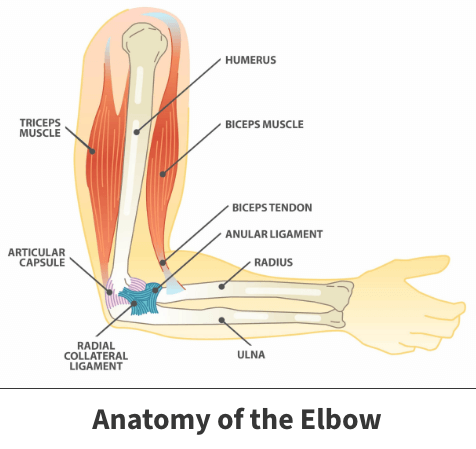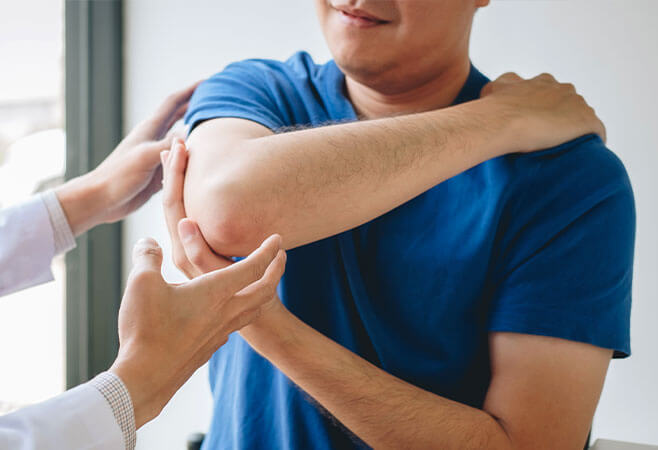Hyperextended elbow
A hyperextension injury of the elbow happens when your elbow is bent back too far the wrong way, causing pain and possible damage to the ligaments in the elbow. It can also cause the elbow bones to dislocate or pop out of place.
A hyperextended elbow usually occurs because the elbow was suddenly forced back during an activity like gymnastics, football, or martial arts. It can also occur when someone falls with their arms stretched out in front or behind the body.
There are both surgical and non-surgical treatments available to help you get back to your daily activities. Regardless of which treatment plan is prescribed, your Florida Orthopaedic Institute physician will make sure it is the best one for you.
Anatomy

The elbow joint is where the upper arm bone (humerus) meets the two forearm bones (radius and ulna). The bony point of the elbow is called the olecranon, located at the upper end of the ulna. This joint consists of several muscles, ligaments, nerves, and tendons. It is both a pivot and hinge joint, meaning it allows you to bend and straighten, as well as twist and rotate your arm. The elbow joint is positioned directly under the elbow skin and has very little protection from muscles or other soft tissues.
About
An elbow hyperextension injury happens when your elbow joint is bent beyond its normal range of motion. When the elbow is bent like this, it can cause damage to the ligaments and bones in your elbow, potentially causing it to dislocate. Elbow hyperextension injuries can happen to anyone, but they are most common among sports players, such as football, boxing, wrestling, gymnasts, tennis players, and weightlifters.
There are several ways to prevent elbow hyperextension injuries. The main thing you can do is use your arms and elbows correctly during sports and activities. It also helps to strengthen the muscles surrounding the elbow. This protects the joint and ensures that it doesn’t bear more weight than it should.
Symptoms
When the hyperextension injury of the elbow first happens, you may hear a popping sound accompanied by instant pain.
Other symptoms of this type of injury include:
- Pain when you touch your elbow
- Swelling around your injured elbow
- Red and blotchy skin around the injured area
- Elbow deformity
- Circulation problems in your hand
- Dull to sharp pain when you move your elbow
- Loss of elbow and arm strength
- Stiffness in your elbow and arm
- Muscle spasms in your biceps when you try to straighten your arm

Diagnosis
Your Florida Orthopaedic Institute physician will take a look at your symptoms and medical history, followed by a medical examination. They may also order some tests to confirm your diagnosis. These tests include:
- X-rays – produce images of dense structures such as bone and rule out any fractures
- Magnetic resonance imaging (MRI) and Computed Tomography (CT) scans – check if soft tissues are damaged
Treatment
A hyperextension injury of the elbow can be treated both surgically and nonsurgically. Nonsurgical treatments are always the preferred treatment option. Surgical procedures are only suggested if the damage is severe or if nonsurgical treatments are not effective. Your Florida Orthopaedic Institute physician will help determine which treatment path is best for you.
Nonsurgical treatment
Immediately after the hyperextension injury, you should ice your elbow to help reduce pain and swelling. You may also want to take over-the-counter anti-inflammatory pain relievers, like aspirin, ibuprofen (Motrin, Advil) or naproxen (Aleve) to help ease swelling and discomfort. Depending on the severity of your elbow hyperextension injury, your Florida Orthopaedic Institute physician may also prescribe some or all the following treatments:
- Compression and elevation – Wrapping the elbow in an elastic bandage helps prevent the joint from moving, while reducing swelling. The wrap should be firm but not so tight it hurts or causes numbness in the arm or hand. If possible, rest your elbow on cushions above the level of your heart during the first days following the injury.
- Rest and restrict movement – It is important to give your elbow the chance to heal. Avoid any activities that involve elbow movement, such as sports. When you need to get back to a daily routine, use a special elbow brace to keep the elbow joint from bending and moving.
- Physical therapy and exercise – Once your elbow hyperextension injury has had the chance to heal and you no longer experience any pain, physical therapy can help strengthen the muscles around your elbow, helping the ligaments continue to heal.
Surgical treatment
If your elbow hyperextension injury damaged your ligaments, tendons, or bones, you may need surgery. During the surgical procedure, the injured ligaments, tendons, or bones are repaired and repositioned, allowing them to heal correctly.
In the weeks following surgery, you will need to keep your arm immobilized. After, you will need to undergo physical therapy to help restore strength and mobility in the elbow.
Videos
Related specialties
- Arthroscopic Debridement of the Elbow
- Aspiration of the Olecranon Bursa
- Cubital Tunnel Syndrome
- Elbow Bursitis
- Elbow Injuries & Inner Elbow Pain in Throwing Athletes
- Golfer's Elbow
- Growth Plate Injuries of the Elbow
- Little Leaguer's Elbow (Medial Apophysitis)
- Olecranon Stress Fractures
- Radial Tunnel Syndrome
- Tennis Elbow Treatment
- Tricep Pain & Tendonitis
- UCL (Ulnar Collateral Ligament) Injuries
- Valgus Extension Overload
